Twenty percent (20%) of small businesses want to improve user engagement in 2019. Producing and publishing diverse content on their websites can small businesses improve user engagement. Small businesses should balance functional and creative content and create useful material for current and potential customers.
High-quality and useful website content is an integral part of website design. When websites are designed around useful, effective content, it creates a better overall user experience (UX).
Small businesses may have small teams and limited resources for designing their websites. Still, they need to invest in both creative and functional content on their websites to effectively engage website users.
We surveyed 529 small businesses in the U.S. to learn about the types of content they publish on their websites, the effectiveness of their content, and the content they plan to publish in 2019.
Small businesses should create and publish website content that's useful for their intended audience. Small businesses can use this report as a guide to creating high-quality, useful content that boosts engagement on their websites.
Our Findings
- One-fifth of small businesses (20%) say enhancing website design is the main priority for their websites in 2019, and 19% want to improve user engagement. Businesses can improve engagement on their websites by creating high-quality content.
- Almost three-fourths of small businesses (74%) publish website content at least monthly, but small businesses with larger teams publish more frequently.
- Over one-third of small businesses (40%) publish information about their company the most, though experts recommend visuals and videos to increase website user engagement.
- Almost one-quarter of small businesses (23%) say visuals and company information were the most effective forms of content they created in 2018, which supports expert recommendations to incorporate more visuals.
- Most small businesses (55%) plan to publish visuals on their websites in 2019, but small businesses can also benefit from investing in emerging forms of content such as podcasts.
Update Website Design to Include Content
Small businesses can achieve their goals of improving design and user engagement on their websites by publishing new, useful content. Almost half of website users say they return to websites with useful content, according to research from Clutch.
Website design must factor in content to truly improve the user experience (UX) of a small business's website. Improving web design is the top website priority for 20% of small businesses in 2019.
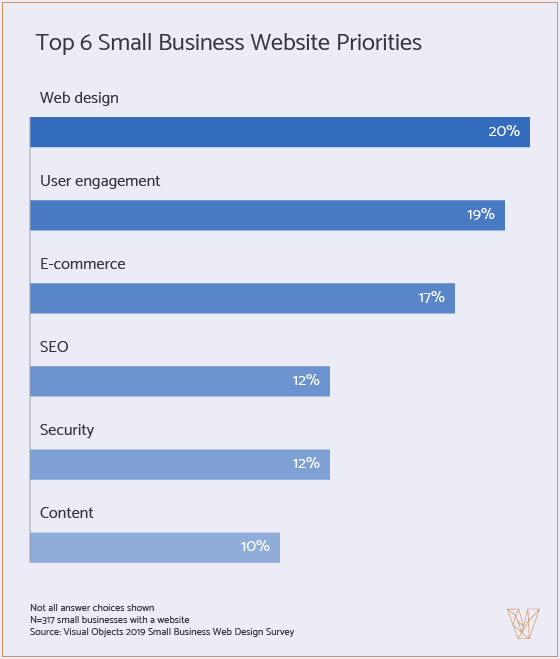
Improving user engagement is the main priority for 19% of small businesses, while 17% will prioritize e-commerce in 2019.
Small businesses can achieve their top priorities simultaneously – enhancing website design features can improve user engagement.
Some small businesses, however, may be unclear about what constitutes a quality website design.
“When I’ve met with … current clients or potential new clients, they know that their website needs to look nice, but they don’t know exactly what that means,” said Fabrizio Colombi, director of business development at Miami digital marketing firm Decographic.
Often, a quality website is not the same as a website that looks nice, Colombi argues.
For small business websites to look up-to-date, they must have a modern feel and be responsive on desktop and mobile.
“Many people that understand their website needs a refresh are looking for a website that looks modern, new, and up-to-date – those websites tend to be responsive,” Colombi said.
Responsive websites often feature modern designs, but the responsiveness across desktop and mobile is what truly helps small businesses improve their web design.
Small businesses should keep their websites up-to-date and design with content in mind to maintain the best UX.
Publish New Website Content Regularly
Small businesses should consistently publish and update content to keep users engaged but not at the expense of content quality.
Content that is current and regularly published shows users that your small business cares about its online presence.
Almost three-fourths of small businesses (74%) published website content at least monthly in 2018.
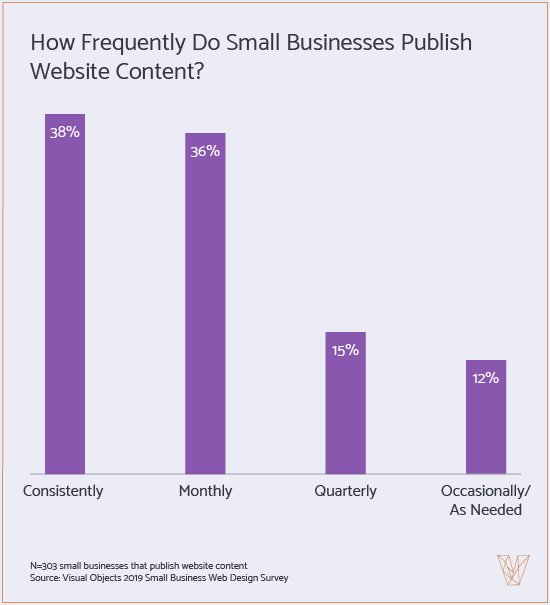
Only 15% of small businesses publish website content quarterly, and just 12% publish new content as needed.
Small businesses with larger teams tend to publish content more frequently: 83% of businesses with over 50 employees publish at least monthly, and only 17% of these businesses publish quarterly or less.
By contrast, 29% of small businesses with 50 employees or fewer publish quarterly or less frequently.
Sam Lloyd, founder of Klicker Inc., a digital and inbound marketing firm in Venice, Calif., recommends that small businesses publish new content to improve their SEO.
“You can nail the content all in one sales swoop, but ongoing content is good for Google,” Lloyd said.
High-quality content is an important opportunity for small businesses to earn backlinks and rank for keywords, both of which positively impact SEO.
Creating and publishing new content consistently, however, is challenging for businesses with smaller teams. Only 35% of small businesses with 50 or fewer employees say they publish new content consistently.
Earl White is co-founder of House Heroes LLC, a Florida-based home buying company. His fifteen-person team publishes content regularly.
“I publish topical content on my website monthly,” White said. “Our strategy is to produce high-quality content that ranks in organic search results. My website also has a fair amount of product pages I create as needed.”
They balance creating content for House Heroes LLC’s blog and about its products.
White and his team, though, face challenges budgeting time for producing content and competing against other real estate firms for attention.
“The biggest challenge in producing and managing website content is time,” White said. “Online content for real estate is also saturated. Only truly engaging content will reach the top of search engines. I’ve hired writers, but they mostly weren’t able to craft content capable of outranking major [real estate] players like Zillow and Redfin.”
To address the challenge of finding the time to create and manage his website content, White relies on freelance writers. Investing in writers, however, has not resulted in higher engagement on his website.
Kristine Neil is the owner and creative director at Markon Brands, a web design and digital marketing company in Vancouver, Wash. that helps small businesses improve their websites. She recommends small businesses create website content in batches.
“Most businesses that are successful at content marketing are not actually writing 2-3 blog posts every week,” Neil said. “Planning ahead not only allows business owners to take the pressure off and no longer have to worry about coming up with something to write about each day, but also to be more strategic and targeted in their content.”
Neil recommends small businesses write multiple pieces of content at a time to plan ahead for busier months.
A comprehensive digital marketing strategy can help small businesses map how to create and regularly publish content on their websites.
Balance Functional and Creative Website Content
Small business websites need to provide basic, functional information about their company to potential website users, but small businesses should use creative content such as blog posts, visuals and videos to do so.
Functional content like company information, reviews, and product descriptions provide information about products, location, contact information, and more.
Creative content such as images and videos makes websites more exciting and eye-catching.
More than one-third of small businesses (40%) published information about their companies in the past year, which signifies that small businesses value functional content.
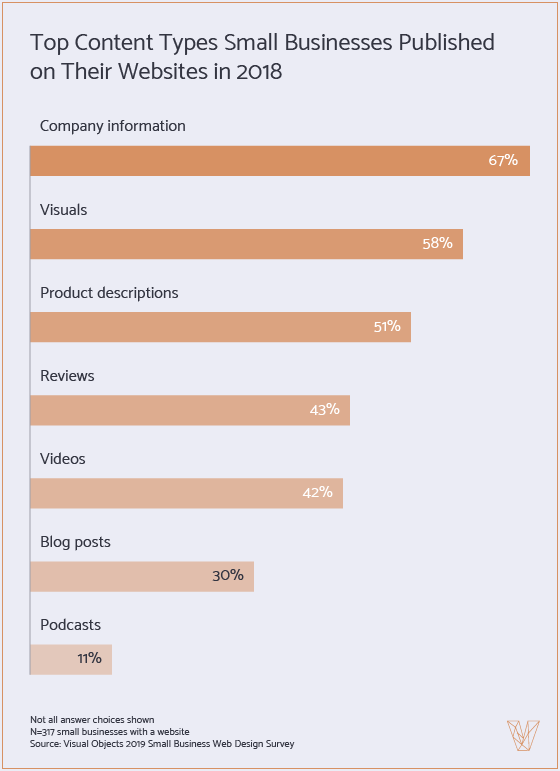
Creative content was also fairly popular in 2018 among small businesses:
- More than one-third (35%) published visuals – photography, infographics, and illustrations.
- One-fourth (25%) published videos
- Eighteen percent (18%) invested in articles or blog posts
Creative content such as visuals, videos, and articles help businesses convey important information to a wide audience.
Businesses can enhance their functional content by incorporating creative elements. For example, a small business might improve the functional company information on their “About Us” page by including a short video introducing the company’s brand, mission, and teammates.
Though creative content can be time- and labor-intensive, it has long-term benefits for small businesses looking to attract leads.
“When we talk about content pieces that are more graphic, like for example, infographics, we explain to the customer that those are not expenses but assets” Colombi said. “They are pieces that the client can use not only on their website but also in their sales process.”
Though investing in content such as infographics or videos may seem challenging, Colombi argues that these forms of content are investments that will help businesses’ long-term growth.
Small business should include essential, functional website content to communicate basic information, but they should also use creative methods like videos to improve engagement with their content.
Publish Images and Videos, But Don’t Neglect Long-Form Content
Visuals and videos on websites are an alternative to traditional, long-form, written content. Small businesses should include both, however, for maximum return on investment for their website content.
Long-form content allows users to take a deep dive into subjects that interest them, while visual and video content allows businesses to repurpose written content as infographics, videos, or pictures of employees on an “About Us” page.

Almost one-fourth of small businesses (23%) say visuals and company information were the most effective forms of content they published in 2018.
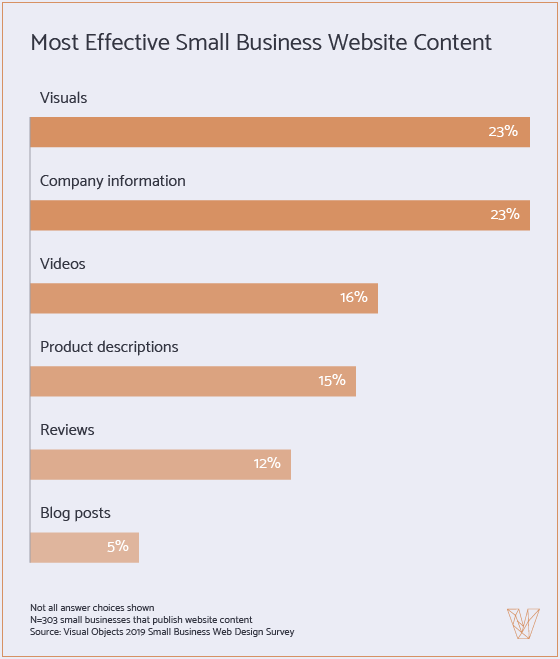
Almost one-fifth of small businesses (15%) say product descriptions are most effective, while only 5% find blog posts and articles effective.
According to research from the Nielsen Norman Group, photos of people and products on websites attract users’ attention better than written content.
Matt Cannon, director of web services at Chicago internet marketing agency Straight North, argues that the value of blog posts and other long-form content depends on industry.
“When you’re dealing with small B2B companies, people aren’t going to a website to read blog posts,” Cannon said. “People spend a few minutes on that site looking to see if you offer the service that they’re looking for and if you can help them.”
A small business considering how to invest in long-form content should research its industry to see how a blog could add value for users first, rather than add a blog for potential SEO benefits.
That doesn’t mean small businesses should completely disregard long-form, written content. Long-form content provides an “evergreen” source of material that can be repurposed for videos, infographics, or other content assets.
Colombi agrees that focusing on SEO makes long-form content ineffective for small businesses, but he believes a user-focused content strategy can make articles’ efficacy more measurable.
“I would argue that they’re actually more effective than people give them credit for,” Colombi said. “If there was a content strategy behind [the articles] to inform their consumers, I think [small businesses] would be able to change that percentage.”
Long-form content should follow a content strategy that keeps users in mind, rather than writing for search engines only.
Visuals and videos can also be used to supplement long-form written content. Instead of writing a 1,000-word blog post, for example, a small business could create a video explainer with a summary or transcription included underneath the video.
Moz’s “Whiteboard Friday” video series is a popular example of supplementary video and long-form written content.
In each post, the video is embedded on the webpage, which also includes screenshots and a transcription of the video.
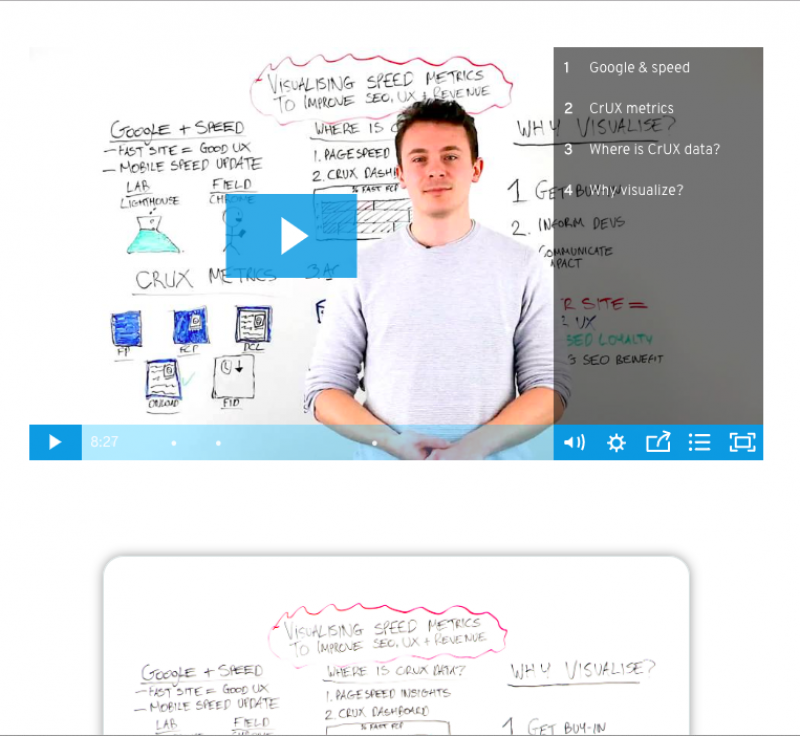
By combining video, visual, and long-form content, Moz sees both engagement and SEO benefits: increased engagement from the video and SEO value from the transcript that follows, which includes keywords and H2’s for Google to index. Most importantly, however, Whiteboard Friday is a helpful resource for Moz’s users.
Small businesses are not limited to long-form or visual content. Using both benefits users and SEO efforts.
Experiment With New Content Formats to Drive Engagement
Functional website content remains a priority for small businesses in 2019, but small businesses can stand out by investing in emerging forms of content such as podcasts and video series.
Most small businesses (57%) plan to publish information about their company, and 48% plan to publish product descriptions, both of which are examples of functional content.
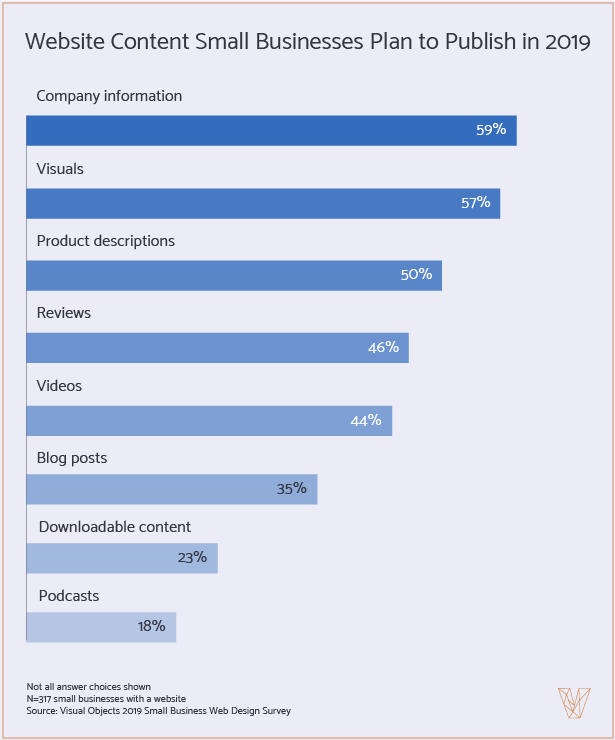
Visuals remain the most popular form of creative content: over half of small businesses (55%) plan to publish visuals on their websites.
Other types of creative content small businesses plan to invest in include:
- Videos (42%)
- Articles and blog posts (33%)
- Downloadable content (22%)
- Podcasts (17%)
Small businesses with larger teams are better equipped to experiment with new types of content. Podcasts, for example, may require more time and special equipment to produce, plus additional time to promote.
Renata Castro, founding attorney at full-service immigration law firm Castro Legal Group, says experimenting with emerging forms of content has benefitted her firm’s entire digital marketing strategy.
“We use social media – creating informative videos on YouTube, as well as interactive videos on Facebook and Instagram Live,” Castro said. “Because of the response I have received from being a guest on other’s podcasts, I am working on a few podcasts directed at different audiences.”
Small businesses should test the efficacy of emerging content such as podcasts and video before investing fully in emerging content hosted on their websites.
Podcasts and Videos Can Help Small Business Branding Efforts
Emerging forms of content can be incorporated into a small business’s overall brand strategy.
Ashley Graham is the CEO and creative director at Brandesso, a brand communications and marketing agency in San Diego.
“We recently launched a video series called Coffee Babble that is both on brand and promotes our business and other influential brands in the industry,” Graham said. “In this series, we highlight and talk enthusiastically about local brands and entrepreneurs who have a special message to share with our audience.”
Coffee Babble, shown below, is a two-minute video that includes Brandesso’s branding and catchy music that grabs audience attention.
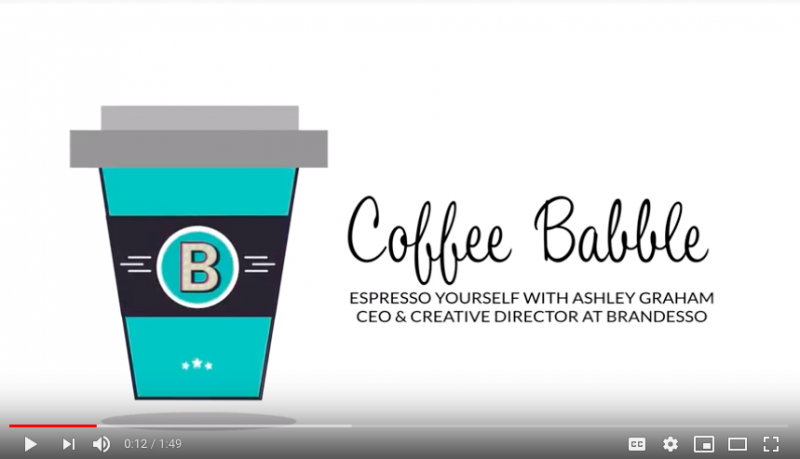
The videos are hosted on YouTube and complement Brandesso’s long-form, “Coffee Break,” blog, which Graham also uses to promote the video series.
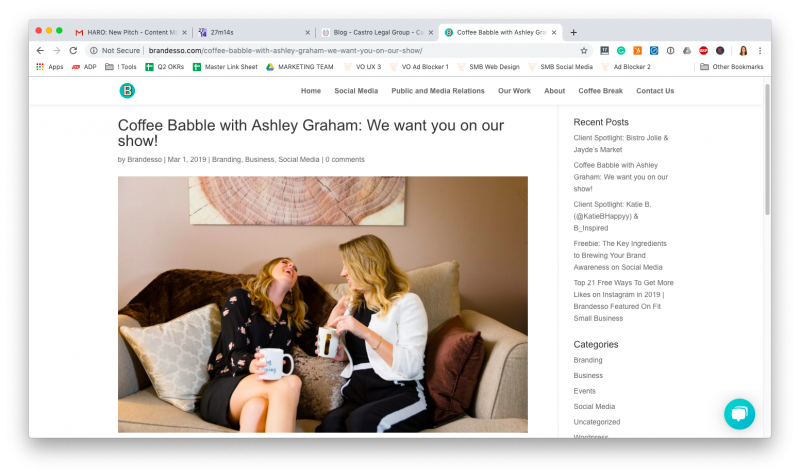
Graham also uses the videos to provide extra content and visibility for her clients.
“We have expanded into six full episodes while turning it into a paid content package for brands to receive the broadcasting and public relations aspect of the piece, as well as lifestyle photos and b-roll clips to use for their social media and marketing strategies,” Graham said.
Small businesses looking to pursue a similar strategy, however, may need to review outside video production resources to create high-quality content.
“We partnered with a local photographer/videographer company to be the facilitators of the filming and editing process, as well as assist with some of the branding aspects of the videos,” Graham said.
By hiring outside help, Graham was able to create a successful video series that improved client engagement and enhanced her brand’s presence.
Video series and podcasts are just two emerging content formats that small businesses can explore to increase website engagement and enhance branding.
Content Management Is Essential for Small Business Websites
Improving website engagement is a top priority for 20% of small businesses in 2019, and website content can help them achieve that goal.
Small businesses should design their websites with content in mind. Helpful, thoughtfully designed content can provide a more intuitive user experience for current and potential customers.
Publishing new website content consistently is critical for small businesses that want to improve website engagement. Creating content in batches and hiring outside writers to assist in content creation helps small businesses with limited budgets manage their web content.
Small businesses need functional website content to provide users with essential information about their company, but creative content such as blog posts, visuals, and videos keep users engaged.
Images and videos provide opportunities to repurpose long-form content, which also benefits small businesses’ SEO.
Small businesses also should invest in new, emerging forms of content such as podcasts, webinars, and video blogs to promote brand engagement.
Small business websites need content to attract and retain customers. By investing in a diverse portfolio of content and working with top web design companies to integrate that content into a website, small businesses can meet their goal of increasing website engagement in 2019.
About the Survey
Visual Objects surveyed 529 small business owners and managers with between 1 and 500 employees across the U.S.
More than half of small businesses (54%) have between 1 and 10 employees, and 46% have between 11 and 500 employees.
Most respondents are male (52%), and 48% of respondents are female.
Millennials (ages 18-34) make up 29% of respondents, 45% are Generation Xers (ages 35-54),and 27% of respondents are baby boomers (ages 55+).